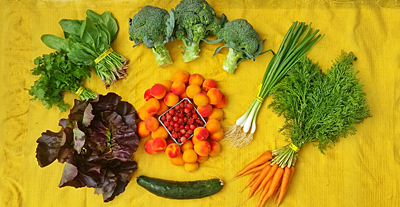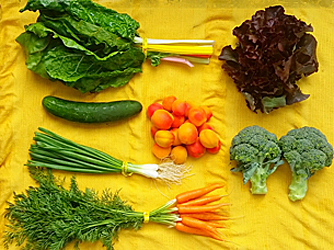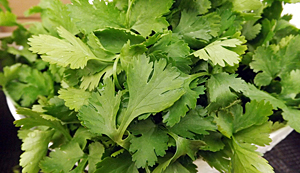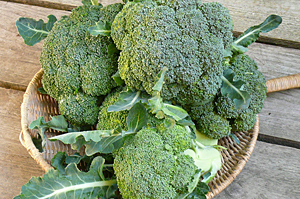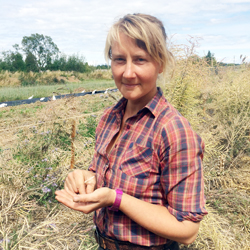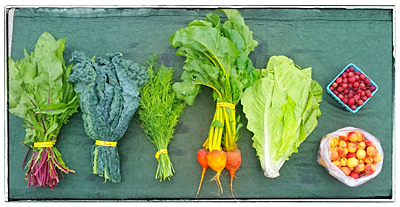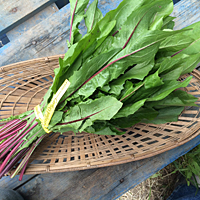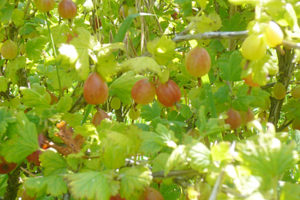In the Standard Box:
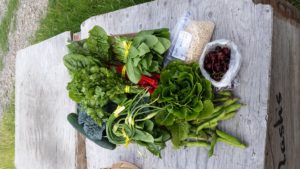
Fava Beans 1.25lb
Romaine Lettuce 1 hd
Red Chard 1 bu
Cucumber
Spinach 2 bu
Cilantro 1 bu
Cherries 1.25 lbs from PDQ Farms
Garlic Scapes 1bu
Lacinato Kale 1bu
Rolled Oats 2lbs
In the Small Box:
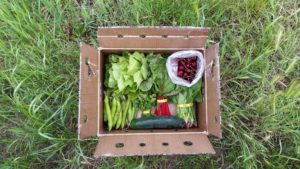
Fava Beans 1.25 lb
Romaine Lettuce 1 hd
Red Chard 1 bu
Cucumber
Spinach 1 bu
Cilantro 1 bu
Cherries 1.25 lbs from PDQ Farms
Box Notes for Week 1
Your naked oats were planted May 2015 and rolled last week. Exceptionally creamy and flavorful, use them as you would any thick, rustic rolled oat—in oatmeal, baked goods, and granola. For stove top oats, quickly remove some of the oat hulls that slipped through the roller, by swirling the oats in water and skimming off any hulls that float to the top.
Basic Oat Crumble Topping — Mix 1.5 cups rolled oats, 1/2 cup flour, 1 cup packed light brown sugar, and any favorite spices (cinnamon, nutmeg, ginger), and a pinch salt with 1 cup unsalted butter by cutting the butter into pieces and mixing it in with your fingers until it’s like coarse crumbs. Add nuts, if you want. Sprinkle it on cut up apples and/or berries in a 9×13 pan. Bake at 375 for about 45 minutes.
Lacinato kale is tender to eat raw in salads (shredded), or sautéed with garlic scapes and basil. Eat the whole leaf, stems and all.
First cucumbers of the season are super juicy and sweet, perfect for salads and snacking. Peeling is optional. The tender (and delicious!) cucumber peel contains the majority of the vegetable’s fiber and lots of potassium and anti-oxidants.
Spinach contains enormous amounts of vitamins K, A, and C; the B vitamins (especially folate); calcium; potassium; and manganese. It is also one of the richest natural sources of lutein, a carotenoid that protects against degenerative diseases of the eye.
Spinach holds up well when combined with strong flavors like anchovies and bacon, or cheddar, feta, and Parmesan cheeses. To season, try cumin, curry, dill, garlic, ginger, horseradish, mace, marjoram, mint, nutmeg, rice vinegar, sesame, or tarragon. Nash’s spinach is so tender it just melts in your mouth. We recommend it quickly sautéed into breakfast egg scrambles, or raw in salads.
Fresh Fava Beans
Fresh fava beans are delicious and packed with vegetable protein. Schuck the beans from the outer pod, but the inner, whitish hull is perfectly edible. However, if you want to remove it, blanch the beans, then quickly plunge them into icy water. Cut a small slit in the white membrane and squeeze out the emerald green beans. Lots of work, but worth the effort, especially if you are preparing something really elegant.
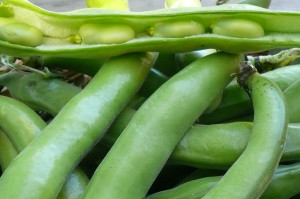
Kia’s Crock Pot Favas & Chicken
Slow cooked favas are tender and pair effortlessly with anything else you want to toss in the pot. Skip the meat and add extra veggies and lots of herbs for a vegetarian meal.
1-2 cups shucked fava beans
Approx. 2-lbs chicken parts, or other meat
2 cups fresh or canned salsa
4 cups of chopped celery, onions, peppers, zucchini, carrots, potatoes, etc.
Approx. two cups of water
Salt and pepper
Fresh or dried oregano, thyme, basil, cilantro, rosemary, etc.
Put all ingredients in crock pot and salt/pepper/herbs as desired. Cover; cook on medium heat overnight, or for 6-8 hours. Add a fresh bunch of roughly chopped spinach/kale/chard the last 30 minutes of cooking, as desired. Serve hot over rice/quinoa/pasta/shredded cabbage etc.
Fava Tip: Approx 1 lb of fresh favas = 1 cup shucked beans
Garlic Scapes
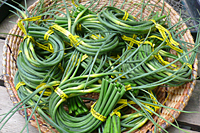
Garlic scapes are the delicious flower bud stem of the garlic plant, which is trimmed late spring to encourage robust bulb development. Scapes have a mild garlic flavor, and can be used like shallots, onions, or garlic in any recipe. Chop them up and then roast, puree into spreads/pesto, sauté, soup, etc.


